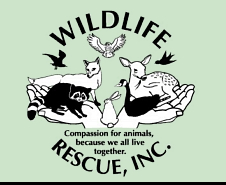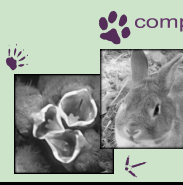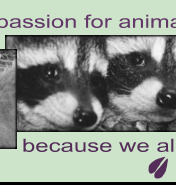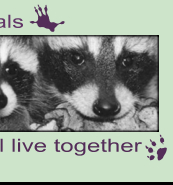First ever Non-Lethal White-Tailed Deer Birth Control Sterilization Spay Project in the history of Maryland on private land in a residential community!
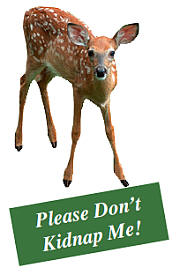 Please Don’t Kidnap That Baby!
Please Don’t Kidnap That Baby!
Each year across the U.S., thousands of “orphaned” wild birds and mammals are rescued by well-meaning people when they didn’t need to be rescued at all.
In the spring and summer, people frequently find baby wild animals and assume they are orphaned. However, whether or not an animal is orphaned depends on the animal's age and species, and how their natural behaviors are perceived. People sometimes assume that an animal found alone means the animal is orphaned. They don't realize that certain animals, like deer and rabbits, commonly leave their young alone to avoid attracting predators with their own scent. While other animals like raccoons are closely supervised by their mothers, so finding a young raccoon alone does indicate that the animal is likely to be an orphan. These guidelines will help you decide whether the baby you are seeing is truly an orphan, and what if anything you should do.
When to Rescue or Not
How to Rescue a Bird or Mammal
How to Prepare A Protective Container
Rescue DON'Ts
About Cat and Dog Bites
Birds
Baby Deer (Fawns)
Rabbits
Squirrels
Opossums
Foxes
Raccoons
About Trapping Other Wildlife
Find a MD
Rehabilitator
• It’s always best to leave what you may think is an “orphaned” animal alone unless it is in obvious distress or in an unsafe location. Quite often, its parents are close by and reluctant to return because you are there. Watch for their return from a safe distance.
• Generally, if no parent returns within one to two hours, you should call a wildlife rehabilitator or begin preparing your protective container. An exception to this rule is a nest of baby bunnies – see Rabbits and baby deer (fawns) – See Deer to learn how to check for Mom’s return.
• Call a wildlife rehabilitator for assistance before rescuing any animal. This is especially important with the rescue of a wild creature of any size or strength.
• Remember, the possibility of exposure to rabies always exists. You must protect yourself and your pet from any contact with a wild animal's saliva and other body fluids.
When to Rescue or Not
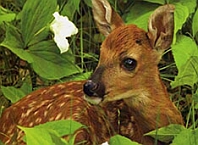 DEER
DEER
Q: I found a fawn all alone – is he
orphaned?
A: People mistakenly assume that a fawn is
orphaned if found alone. Rest assured that the mother
deer is nearby. The doe will only visit and nurse her
fawn a few times a day to avoid attracting predators. At
four weeks old, the fawn will begin to travel with his
mother. Just leave the fawn alone unless you know that
the mother is dead. Mother deer are wary of human
smells; if you have already handled the fawn, take a
towel, rub it in the grass, and then wipe down the fawn
to remove all human scent. Using gloves, promptly return
the fawn to where he was found. However, if the fawn is
lying on his side, or wandering and crying incessantly,
they need help. Wounded wildlife are susceptible to
maggots that get into wounds in the summer heat from
flies. This is especially common with fawns that are
attacked by dogs. The fawn will need to be treated for
maggots immediately or it will die. Contact a wildlife
rehabilitator or veterinarian in your area if you think
the fawn has been bitten by a dog. Do not chase a fawn.
In most cases this will cause too much stress and can
kill the baby deer. But remember, a fawn found alone and
quiet is OK!
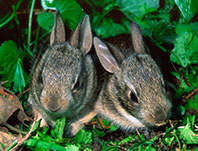 RABBITS
RABBITS
Q: I found a nest of baby rabbits. Are they
orphaned?
A: If the nest is intact and the babies are
not injured, leave them alone! Mother rabbits only visit
their young 2-3 times a day to avoid attracting
predators. If the nest has been disturbed, or if you
think the babies are orphaned, recover the nest with
surrounding natural materials, such as grass, leaves and
fur, and put an “X” of sticks or yarn over the nest to
assess if the mother is returning to nurse her young. If
the “X” is moved but the nest is still covered by the
next day, the mother has returned to nurse them. If the
“X” remains undisturbed for 24 hours, they need help.
BIRDS
Q: Baby birds fell from their nest and I
touched them – will the parents reject them now?
A: It's a myth that birds abandon their
chicks if a person touches them. Unlike other animals,
birds are not sensitive to the human scent. Just put the
baby birds back in their nest if safe to do so. If the
original nest was destroyed or is too high to reach,
hang a wicker or woven stick basket close to where the
original nest was. Woven stick baskets make perfect
substitute nests: they resemble natural nests and allow
rain to pass through so the birds don't drown. However,
make sure the basket isn't too deep - adult birds will
not jump into anything they can't see out of. You should
watch for an hour to make sure that the parent birds
return to the new nest to feed their chicks. If they
don't return, then help is needed.
Q: There’s
a bird outside that can’t fly. Is he injured?
A: If it's summertime and the bird is
almost full-sized, fully feathered, but has short tail
feathers, he may be a fledgling. Often birds leave the
nest several days before they are able to fly. This is
normal, as birds learn to fly from the ground up. Stand
back and look for parent birds who will fly over to feed
their fledgling a few times per hour. For several days,
the fledgling may remain on the ground but the parents
will supervise and teach their young how to hunt for
food- so it is very important to leave the fledgling
there! Be sure to keep your companion animals indoors
during this period. If there are cats or dogs in the
area whom you can't control, put the fledgling in a
basket and hang the basket securely from a nearby tree
limb. Hopefully, this will keep the bird off the ground
for the few extra days he needs before he can fly.
However, if the bird appears injured and/or alone, or in
imminent danger, they need help.
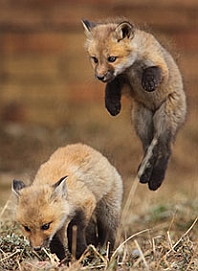 FOXES
FOXES
Q: I see fox kits (pups) playing by
themselves – but no parent is around. Are they orphaned?
A: Often fox kits will appear unsupervised
for long periods of time while both parents are out
hunting for food. Observe the kits from a distance. If
they seem energetic and healthy, just leave them alone.
Call Wildlife Rescue, Inc. if the kits appear sickly or
weak, or if you have reason to believe both parents are
dead.
OPOSSUMS
Q: I found a baby opossum – is he orphaned?
A: Baby opossums are born as embryos,
barely larger than a bee. They crawl up to their
mother’s pouch where they spend about 2 months attached
to one of her 13 nipples. Sometimes when baby opossums
get to be about 3-4 inches long, they ride around on
mother’s back – if they fall off, she may not know they
are missing. The general rule is if the opossum is less
than 7 inches long (without the tail) he is an orphan.
Over 7 inches long, he’s old enough to be on his own!
SQUIRRELS
Q: There’s a baby squirrel outside under a
tree – is he orphaned?
A: If tree work was recently done and the
nest or baby fell down as a result, give the mother a
chance to reclaim her young. If the baby fell from the
tree uninjured, leave him where he is, leave the area
and keep people and companion animals away. Monitor from
a safe distance; if the baby is not retrieved by
night-time, contact Wildlife Rescue, Inc. If there is a
risk of predation, you can put the squirrel in a wicker
basket and attach the basket securely to the tree. Do
not cover the squirrel with leaves or blankets because
the mother may not be able to find him. If it is chilly
outside, or if the baby isn't fully furred, provide him
with a heat source, such as a heating pad or a hot water
bottle.
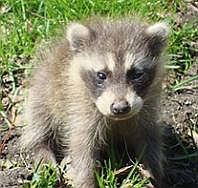 RACCOONS
RACCOONS
Q: There’s a baby raccoon outside wandering
around – is he orphaned?
A: If the baby raccoon has been seen alone
for more than a few hours then he has probably lost his
mother, since mother raccoons closely supervise their
young and don’t let them out of their sight. You can put
an upside down laundry basket over the baby (with a
weight on top) and monitor for a few hours. Ask around
to see if anyone in the neighborhood trapped an adult
raccoon or saw one hit by a car. If the mother does not
return then call Wildlife Rescue, Inc.
A
WORD ABOUT TRAPPING
Please note that the
live trapping of "nuisance" wildlife often leads to wild
animal babies being unintentionally orphaned. This is
because spring and summer are when many wild animals
attempt to use chimneys, attics, and outbuildings as
sites in which to raise their young. It may seem like a
kind solution to trap and relocate a wild animal, but a
high mortality rate among relocated animals, and orphans
being left behind to starve, are the all-too-frequent
results. We strongly discourage the trapping of wildlife
for these reasons.
www.urbanwildliferescue.org/humane
will tell you lots of ways to use humane eviction
without trapping and without harming the animal if an
animal is in your house, attic, yard or a visiting
nuisance.
Other
Wildlife
If you see other wild
animals in distress, especially creatures of size or
strength, as well as mammals that are classified as
rabies vector species, such as raccoons and foxes, call
a wildlife rehabilitator immediately for assistance.
Only a State-licensed and specially trained wildlife
rehabilitator should handle these animals.
To Find a Maryland
Rehabilitator in Your Area go to:
http://dnr2.maryland.gov/wildlife/Pages/plants_wildlife/rehabilitators.aspx
How to Rescue a Bird
or Mammal
First, wear gloves, if
possible – animals may bite or scratch to protect
themselves. Also, wild animals commonly have parasites,
like fleas, ticks or lice, and can carry disease.
To capture a small,
immobile bird, approach it slowly with some paper towels
or a soft cloth and gently pick it up. Then, carefully
place the bird in your protective container.
Approach larger birds
and other immobile animals with a blanket and gently
cover the entire animal to keep it quiet. Carefully lift
the creature and place it in a covered protective box or
animal carrier. Place the box in a warm, dark, quiet
place and keep children and pets away. Do not handle or
bother the creature – stress kills!
Wash your hands to
prevent the spread of disease or parasites to you or
your pets. Don’t give the creature food or water – milk
is especially deadly! Get the bird or mammal to a
wildlife rehabilitator as soon as possible. Timing is
crucial!
How
to Prepare Your Protective Container
1. Punch air
holes into the top of a cardboard box large enough to
hold the creature (but small enough that it cannot run
or fly around inside and injure itself even further).
2. Line the bottom of
the box with paper towels, a soft cloth or toilet
tissue.
3. Keep orphaned babies
and injured animals warm. If possible, put a hot water
bottle, closed tightly to avoid leakage and wrapped in a
towel, in another part of the box, to avoid direct
contact with the creature. (You may also use double
zip-lock plastic bags filled with warm water and covered
with a cloth - use 2 in case one leaks!)
4. Once the creature is
in the box, securely tape or rubber band the container
shut.
5. Bring the bird or
mammal to Wildlife Rescue a wildlife rehabilitator right
away!
Rescue DON'Ts
Often
knowing what not to do is just as important as knowing
what to do. Here are a few things you should NEVER do:
• DON’T give water or
food (including milk, which is especially deadly!) to an
injured or orphaned animal.
• DON’T leave pets or
children outside when a fledgling is on the ground.
• DON’T cut a tree down
without looking for wildlife to see if there’s a
squirrel, bird or raccoon nest in the tree.
• DON’T allow pets or
children to disturb a rabbit’s nest.
• DON’T keep a wild
animal as a pet.
About Cat and Dog Bites
. . .
If you suspect that an
animal has been caught or bitten by a cat or dog– even
if no puncture wounds are visible – the creature must be
put on antibiotics right away. Bacteria in a cat’s
saliva will cause infection, and, if untreated, the
animal will die. Wounded wildlife are also susceptible to
maggots that get into wounds in the summer heat from
flies. This is especially common with fawns that are
attacked by dogs. The fawn will need to be treated for
maggots immediately or it will die. Contact a wildlife
rehabilitator or veterinarian in your area.
If after reading the
above you still need help in Baltimore County, MD call
410-357-5179. If you want more information on our deer
birth control project call 443-912-8234.
Quality of Care and
Operating Efficiency
Wildlife Rescue, Inc.
has received the award known as the "Best in America"
Seal. This award is extended to only 5% of the
charities that participate in the Combined Federal
Campaigns. We take pride in receiving this award,
which is not only a reflection of the quality of care
we provide but also recognition of the efficiency of
our administrative and fundraising activities. This
efficiency is demonstrated by the fact that more than
86 cents of every dollar donated is used directly for
the animals under our care.
